
Brackish water, sometimes termed brack water, is water occurring in a natural environment that has more salinity than freshwater, but not as much as seawater. It may result from mixing seawater and fresh water together, as in estuaries, or it may occur in brackish fossil aquifers. The word comes from the Middle Dutch root brak. Certain human activities can produce brackish water, in particular civil engineering projects such as dikes and the flooding of coastal marshland to produce brackish water pools for freshwater prawn farming. Brackish water is also the primary waste product of the salinity gradient power process. Because brackish water is hostile to the growth of most terrestrial plant species, without appropriate management it is damaging to the environment.

The burbot, also known as bubbot, mariah, loche, cusk, freshwater cod, freshwater ling, freshwater cusk, the lawyer, coney-fish, lingcod, or eelpout, is a species of coldwater ray-finned fish native to the subarctic regions of the Northern hemisphere. It is the only member of the genus Lota, and is the only freshwater species of the order Gadiformes. The species is closely related to marine fish such as the common ling and cusk, all which belonging to the family Lotidae (rocklings).

The ide, or orfe, is a freshwater fish of the family Cyprinidae found in larger rivers, ponds, and lakes across Northern Europe and Asia. It has been introduced outside its native range into Europe, North America, and New Zealand. It is a popular ornamental fish, usually kept in outdoor ponds in temperate regions from which it often escapes.

Coregonus lavaretus is a species of freshwater whitefish, in the family Salmonidae. It is the type species of its genus Coregonus.

The zander, sander or pikeperch, is a species of ray-finned fish from the family Percidae, which also includes perch, ruffe and darter. It is found in freshwater and brackish habitats in western Eurasia. It is a popular game fish and has been introduced to a variety of localities outside its native range. It is the type species of the genus Sander.
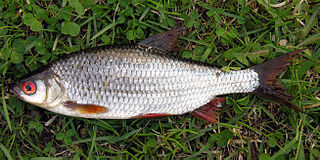
The roach, or rutilus roach, also known as the common roach, is a fresh- and brackish-water fish of the family Cyprinidae, native to most of Europe and western Asia. Fish called roach can be any species of the genera Rutilus, Leucos and Hesperoleucus, depending on locality. The plural of the term is also roach.

The European sprat, also known as bristling, brisling, garvie, garvock, Russian sardine, russlet, skipper or whitebait, is a species of small marine fish in the herring family Clupeidae. Found in European, West Asian and North African waters, it has silver grey scales and white-grey flesh. Specific seas in which the species occurs include the Irish Sea, Black Sea, Baltic Sea and Sea of the Hebrides. The fish is the subject of fisheries, particularly in Scandinavia, and is made into fish meal, as well as being used for human consumption. When used for food it can be canned, salted, breaded, fried, boiled, grilled, baked, deep fried, marinated, broiled, and smoked.
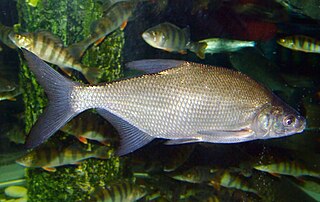
The common bream, also known as the freshwater bream, bream, bronze bream, carp bream or sweaty bream, is a European species of freshwater fish in the family Cyprinidae. It is now considered to be the only species in the genus Abramis.
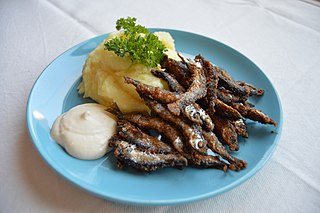
Coregonus albula, known as the vendace or as the European cisco, is a species of freshwater whitefish in the family Salmonidae. It is found in lakes in northern Europe, especially Finland, Latvia, Lithuania, Sweden, Russia and Estonia, and in some lakes of Norway, the United Kingdom, northern Germany, and Poland. It is also found in diluted brackish water in the Gulfs of Finland and Bothnia, both of which are in the Baltic Sea.

The European perch, also known as the common perch, redfin perch, big-scaled redfin, English perch, Euro perch, Eurasian perch, Eurasian river perch, Hatch, poor man's rockfish or in Anglophone parts of Europe, simply the perch, is a predatory freshwater fish native to Europe and North Asia. It is the type species of the genus Perca.
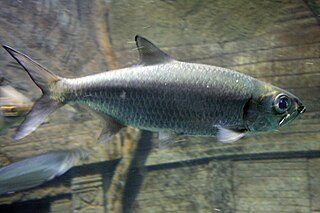
The Indo-Pacific tarpon, also known as the oxeye herring or simply herring due to its superficial resemblance to the true herrings, of which it is not a member, is the smaller of the two species of tarpon and lives in Indo-Pacific waters.

The black goby is a species of ray-finned fish found in the Eastern Atlantic and Mediterranean Sea and Black Sea. It inhabits estuaries, lagoons, and inshore water over seagrass and algae. It feeds on a variety of invertebrates and sometimes small fish. This species can also be found in the aquarium trade.
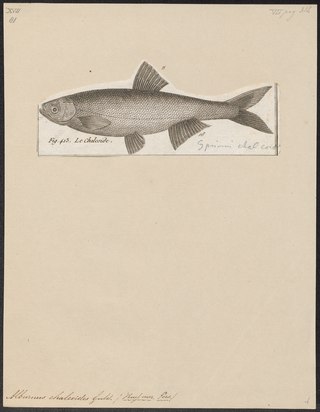
The Danube bleak or Caspian shemaya is a species of freshwater fish in the family Cyprinidae. It is found in Iran, Ukraine, Georgia, Armenia, Slovakia, Moldova, Greece, Czechia, Azerbaijan, Turkiye, Afghanistan, Austria, Bosnia and Herzegovina, Bulgaria, Croatia, Switzerland, Germany, Hungary, Italy, Romania, Russia, Serbia, Slovenia, Turkmenistan, and Uzbekistan.

The stone loach is a European species of fresh water ray-finned fish in the family Nemacheilidae. It is one of nineteen species in the genus Barbatula. Stone loaches live amongst the gravel and stones of fast flowing water where they can search for food. The most distinctive feature of this small fish is the presence of barbels around the bottom jaw, which they use to detect their invertebrate prey. The body is a mixture of brown, green and yellow.
The glassy sprat is a type of sprat fish. The fish, when alive, is translucent, so it gets the second word in its scientific name from the Latin word translucidus, meaning transparent, diaphanous. In animal classification the glassy sprat belongs to Osteichthyes, Clupeiformes, Clupeidae, Hyperlophus. The glassy sprat is native to Australia and mainly found in Australia. It is marked as NE because it has not yet been evaluated by the World Animal Protection. It is mainly used as an economical aquatic product. In ecosystems, they are at the bottom end of the food chain, feeding mainly on plankton, which are less aggressive and very vulnerable to other fish. Glassy sprat are tiny in size and translucent with a silvery streak that extends from its tail to just behind its head. As early as a hundred years ago, Australians harvested the glassy sprat in large quantities and it featured on the table as food for a long time. Due to its poor appearance, it is not a very good ornamental fish.

The allis shad is a widespread Northeast Atlantic species of fish in the Alosidae family. It is an anadromous fish which migrates into fresh water to spawn. It is found in the eastern Atlantic Ocean, the western Baltic Sea and the western Mediterranean Sea. In appearance it resembles an Atlantic herring but has a distinctive dark spot behind the gill cover and sometimes a row of up to six spots behind this. It sometimes hybridises with the twait shad. This fish becomes mature when three or more years old and migrates to estuaries, later swimming up rivers to spawn. Populations of this fish have declined due to overfishing, pollution and habitat destruction. Conservation of this species is covered by Appendix III of the Bern Convention and Appendix II and V of the European Community Habitats Directive.

The fourhorn sculpin is a species of ray-finned fish belonging to the family Cottidae, the typical sculpins. This species has a Holarctic distribution and can be found in marine, brackish and fresh waters.
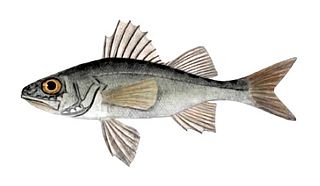
Common percarina is a species of fish in the family Percidae. It is found in northwestern Black Sea basin in estuaries and coastal lakes, and in the lower reaches of the rivers that drain into that part of the Black Sea. It is a carnivorous species.

The European flounder is a flatfish of European coastal waters from the White Sea in the north to the Mediterranean and the Black Sea in the south. It has been introduced into the United States and Canada accidentally through transport in ballast water. It is caught and used for human consumption.

Toxotes chatareus, sometimes known by the common names common archerfish, seven-spot archerfish or largescale archerfish, is a species of perciform fish in the archerfish genus Toxotes.




















